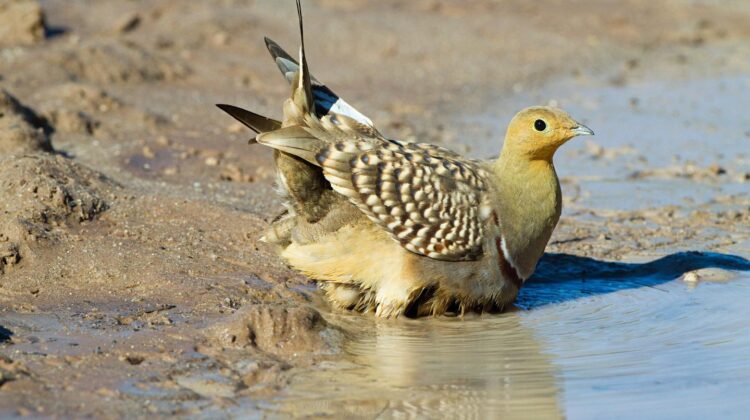
Scientists at Johns Hopkins University and MIT have used high-resolution microscopes and 3D technology to capture an unprecedented view of feathers from the desert-dwelling sandgrouse, which they say could inspire the next generation of absorbent materials. Male sandgrouse have the unique ability to carry about 15 per cent of their body weight in water in their feathers.
‘It’s super fascinating to see how nature managed to create structures so perfectly efficient to take in and hold water,’ said Jochen Mueller, an assistant professor in Johns Hopkins’ Department of Civil and Systems Engineering who specialises in smart materials and design. ‘From an engineering perspective, we think the findings could lead to new bio-inspired creations.’
In order to stay safe from predators, sandgrouse, which are found in African deserts, typically nest about 30 kilometres from waterholes. To get water home to thirsty chicks, the adult males soak up water in their feathers and then fly home with it, a journey that typically takes about a half hour. The male sandgrouse is the only bird known to hold water in this way, a feat made possible by their specially adapted belly feathers.
Mueller and MIT engineer Lorna J Gibson zeroed in on the microstructure of the belly feathers using scanning electron microscopy, microcomputed tomography, light microscopy and 3D videography, looking closely at the shafts, each of which is just a fraction of the width of a human hair, and the even tinier individual barbules. The team greatly magnified the feathers, observing them both dry and wet. Then, in a move as delicate as it was crucial, the dry feathers were dunked in water, pulled out, then re-submerged, just like a sandgrouse at a watering hole, while still being magnified.
‘When you do that type of work, you can’t even breathe or else you blow it away,’ Mueller said.
Mueller described the individual feather structure as ‘magnificent’, with components optimised in several ways to hold and retain water, including the way they bend, how the barbules form protective tent-like clusters when wet, and how tubular structures within each barbule capture water.
Individual feathers held the water through a forest of barbules near the shaft, working together with the curled barbules near the tip acting almost like caps. ‘That’s what excited us – to see that level of detail,’ Mueller said. ‘This is what we need to understand in order to use those principles to create new materials.’
The team also computationally modelled the water intake of the feathers.
Mueller and Gibson expect their findings to underpin future engineering designs that require controlled absorption, secure retention and easy release of liquids. Possible applications include the design of netting for collecting and retaining water from fog and dew in desert regions, and a water bottle designed for runners that prevents the annoying swinging and sloshing of the contained liquid.
Another potential application is in next-level medical swabs that are easier to use, ‘where you can efficiently soak up liquid, but it’s much easier to release it’, Mueller said, adding that the release feature was an issue for collecting Covid-19 nasal test samples during the pandemic.
The team now plans to print similar structures in 3D and pursue commercial applications.
The research has been published in the Journal of the Royal Society Interface.


